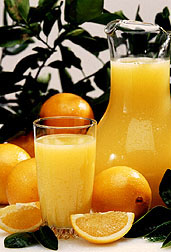This page has been archived and is being provided for reference purposes only. The page is no longer being updated, and therefore, links on the page may be invalid.
| Read the magazine story to find out more. |
|
|
|
|
Fighting Back Against Citrus Greening
By Dennis O'BrienJanuary 25, 2013
U.S. Department of Agriculture (USDA) scientists in Fort Pierce, Fla. are helping citrus growers and juice processors address the threat posed by Huanglongbing (HLB), a disease that is costing the citrus industry millions of dollars each year.
Citrus trees infected with HLB, also called citrus greening, usually die within five to 10 years. Fruit on infected trees often falls to the ground before harvest, and fruit that remains on trees may become misshapen and sometimes only partially ripen.
Supervisory horticulturalist Elizabeth Baldwin with USDA's Agricultural Research Service (ARS) in Fort Pierce is investigating the effects of HLB on the taste of orange juice produced from diseased trees. Her goal is to provide help while a permanent solution is found.
She and her colleagues at the agency's U.S. Horticultural Research Laboratory evaluated fruit with or without HLB symptoms—produced over two growing seasons—for a number of fruit and juice characteristics. They compared Midsweet, Hamlin, and Valencia oranges, the three principal varieties harvested for processing, and used gas and liquid chromatography to analyze juice compounds.
They found that orange juice from the fruit with HLB symptoms was often higher in limonin and nomilin, compounds that can give the juice a bitter taste, but that the compounds were generally below levels that could be detected by human taste panels. Their results were published in the Journal of Agricultural and Food Chemistry.
In another study, they investigated how HLB infection affects juice quality in the same three varieties of orange with respect to cultivar, maturity, and processing methods. The results showed tremendous variability, depending on the harvest date and variety of orange. In general, the researchers found more of a problem with off-flavored juice from diseased Hamlin orange trees than with diseased trees of the Valencia and Midsweet varieties.
But the researchers concluded that using some fruit that has HLB symptoms would not cause problems in commercial operations as long as fruit with and without symptoms, harvested from several varieties, locations, and seasons, was mixed together. Those results were published in the Journal of Food Science.
ARS is the USDA's principal intramural scientific research agency, and this research supports the USDA goal of promoting international food security.

